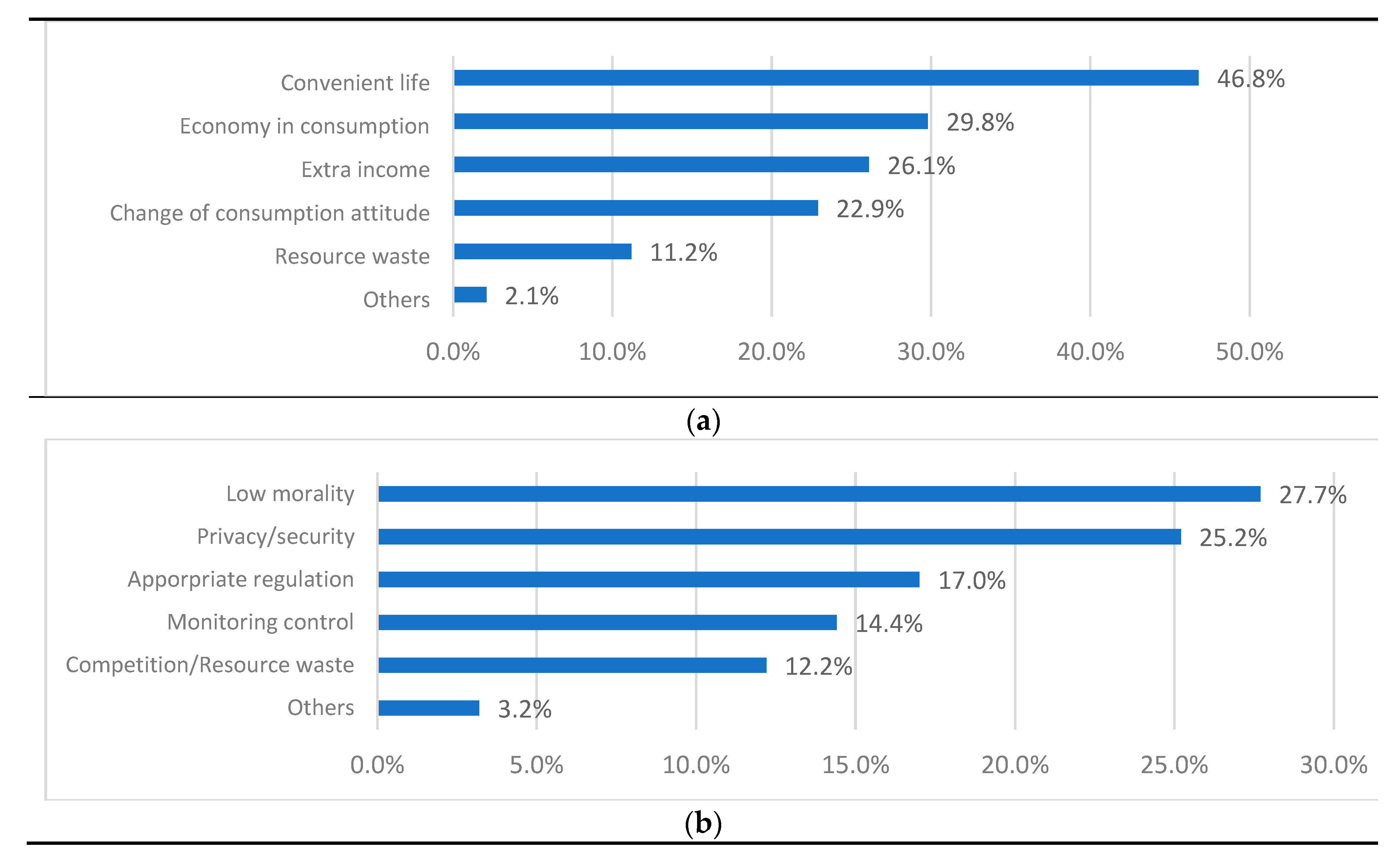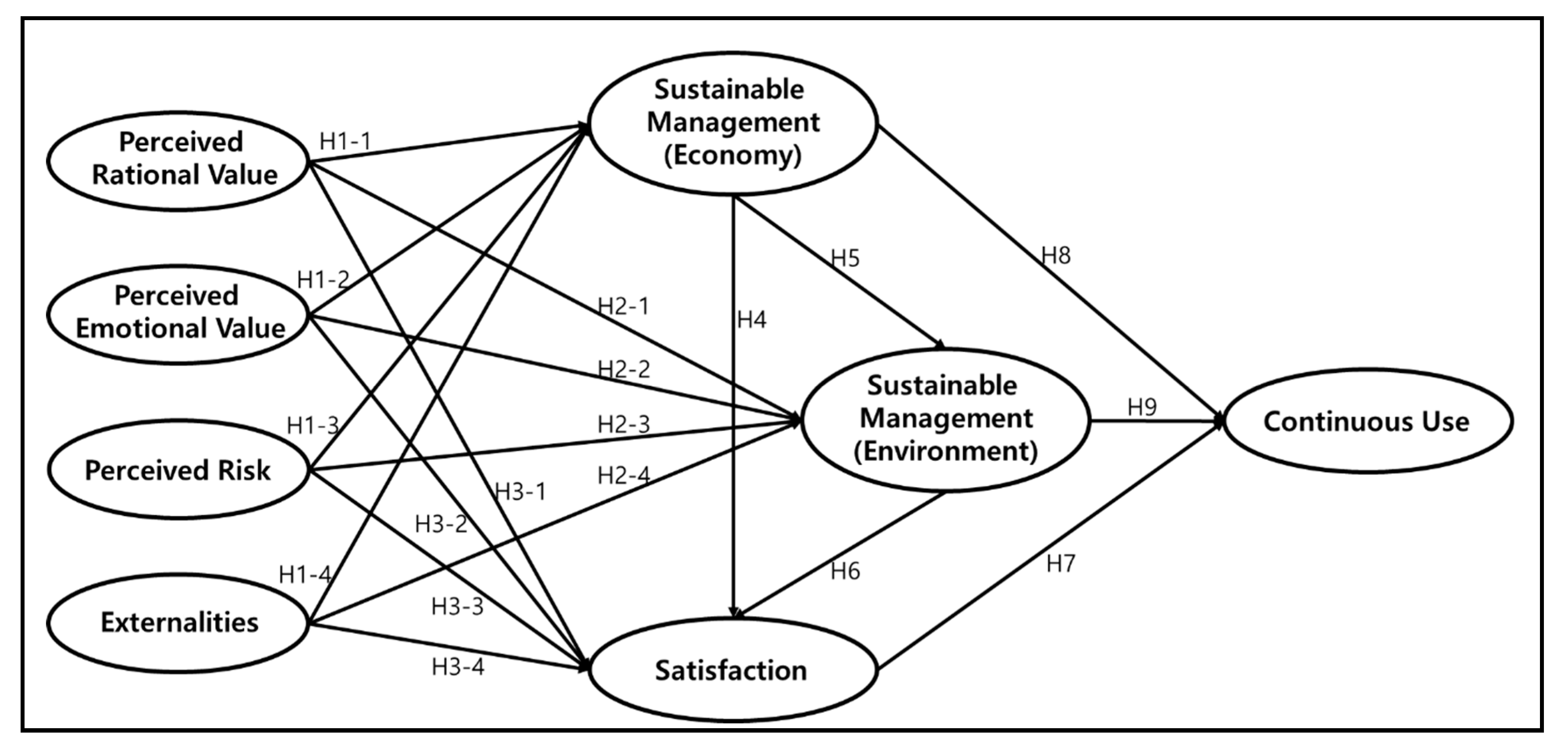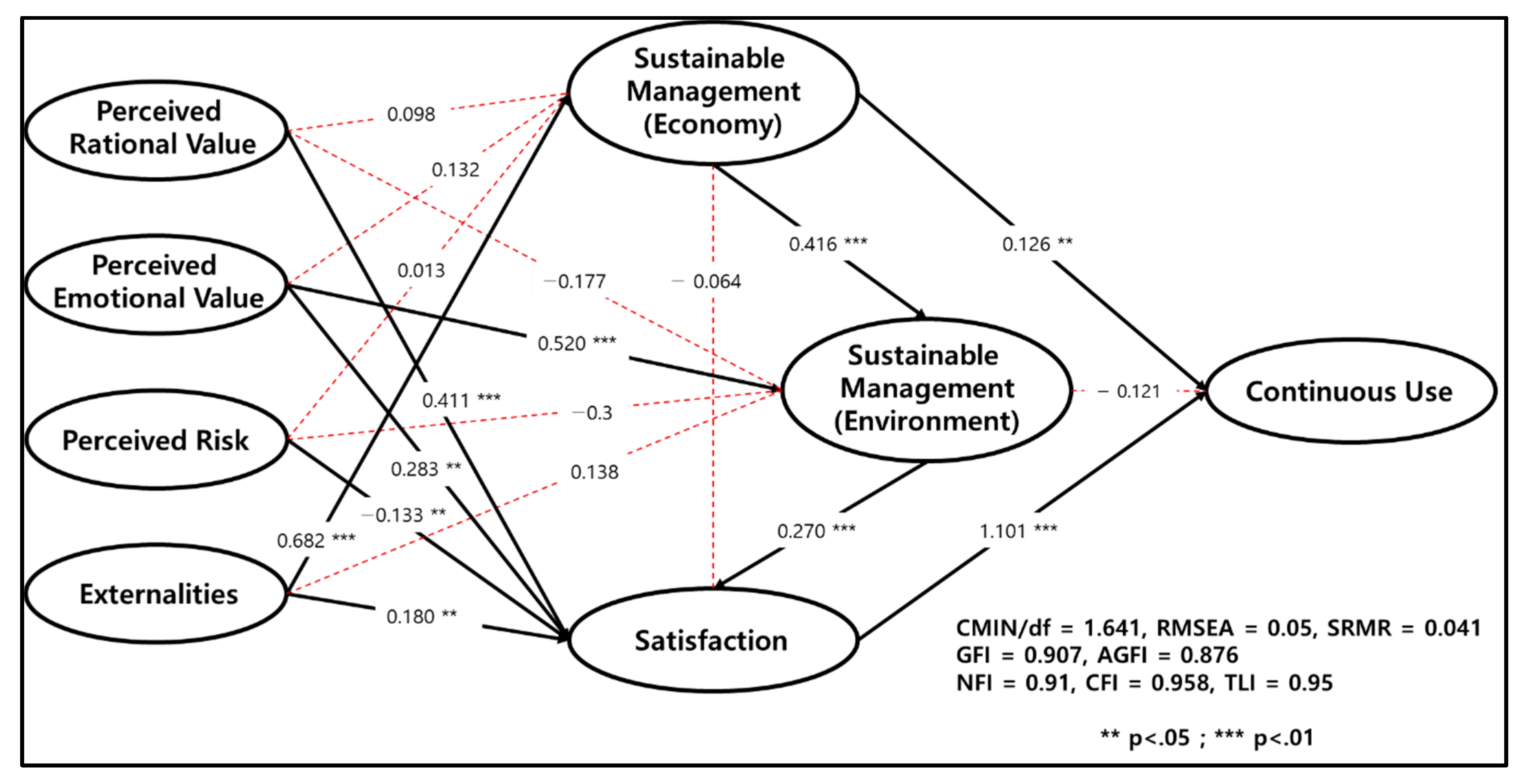Sustainable Governance of the Sharing Economy: The Chinese Bike-Sharing Industry
Abstract
1. Introduction
2. Literature Review
2.1. Conceptual Characteristics of the Sharing Economy
2.2. Researches on the Sharing Bike Industry
3. Operational Definitions of the Variables and Hypotheses
3.1. Perceived Rational and Emotional Values
3.2. Perceived Risk
3.3. Positive Externality
3.4. Sustainable Economic and Environmental Factors
3.5. Satisfaction
3.6. Continuous Use Intention
4. Methods and Data
4.1. Data Collection and Descriptive Statistics of the Data
4.2. Reliability Test, Convergent and Discriminant Validity Test
5. Empirical Results
5.1. Structural Model Result and its Implication
5.2. Modulating Effects and Its Implication
6. Conclusions and Policy Implications
Author Contributions
Funding
Conflicts of Interest
References
- Lessig, L. Remix: Making Art and Commerce Thrive in the Hybrid Economy; Penguin Press: New York, NY, USA, 2008. [Google Scholar]
- Leaders, Y.G. World Economic Forum Annual Meeting 2016 Mastering the Fourth Industrial Revolution. Available online: http://www3.weforum.org/docs/WEF_AM16_Report.pdf (accessed on 27 March 2019).
- Botsman, R. The Sharing Economy Lacks A Shared Definition Fast Company. Available online: http://www.fastcoexist.com/3022028/the-sharing-economy-lacks-a-shared-definition (accessed on 7 January 2019).
- Roland Berger. Bike Sharing 5.0: Market Insights and Outlook; Roland Berger: Berlin, Germany, 2018. [Google Scholar]
- Hardin, G. The Tragedy of the Commons. Science 1968, 162, 1243–1248. [Google Scholar] [PubMed]
- Verified Market Research. Bike Sharing Market Rising Trends, Demands and Growing Business Opportunities (2019–2026). Available online: https://www.verifiedmarketresearch.com/product/bike-sharing-market/ (accessed on 10 September 2019).
- Rinne, A. China’s Sharing Economy: What Is Going On? Available online: https://medium.com/@aprilrinne/chinas-sharing-economy-what-is-going-on-cc9f7536b502 (accessed on 7 January 2019).
- China Info-Telecommunication Center. China’s Sharing Economy Annual Report 2017;2018;2019. Available online: http://www.sic.gov.cn/Column/568/0.htm (accessed on 24 October 2019).
- iiMedia Research. 2018–2019 Sharing Economy Industry Annual Report in China. Available online: https://www.iimedia.cn/c400/66502.html (accessed on 24 October 2019).
- Botsman, R.; Rogers, R. Beyond zipcar: Collaborative consumption. Harvard Bus. Rev. 2010. Available online: http://hbr.org/2010/10/beyond-zipcar-collaborative-consumption/ (accessed on 7 January 2019).
- Gold, L.; Naughton, M. New Financial Horizons: The Emergence of an Economy of Communion; New City Press: New York, NY, USA, 2010. [Google Scholar]
- Möhlmann, M. Collaborative consumption: Determinants of satisfaction and the likelihood of using a sharing economy option again. J. Consum. Behav. 2015, 14, 193–207. [Google Scholar] [CrossRef]
- Hamari, J.; Sjöklint, M.; Ukkonen, A. The Sharing Economy: Why People Participate in Collaborative Consumption. J. Assoc. Inf. Sci. Technol. 2015, 67, 1–13. [Google Scholar]
- Tussyadiah, L.P. Factors of Satisfaction and Intention to Use Peer-to-Peer. Intl. J. Hosp. Manag. 2016, 55, 70–80. [Google Scholar] [CrossRef]
- Sung, E.; Kim, H.; Lee, D. Why Do People Consume and Provide Sharing Economy Accommodation?—A Sustainability Perspective. Sustainability 2018, 10, 2072. [Google Scholar] [CrossRef]
- Zhang, T.C.; Jahromi, M.F.; Kizildag, M. Value co-creation in a sharing economy: The end of price wars? Intl. J. Hosp. Manag. 2018, 71, 51–58. [Google Scholar] [CrossRef]
- Toni, M.; Renzi, M.F.; Mattia, G. Understanding the link between collaborative economy and sustainable behaviour: An empirical investigation. J. Clean. Prod. 2018, 172, 4467–4477. [Google Scholar] [CrossRef]
- Wang, Y.; Xiang, D.; Yang, Z.Y.; Ma, S.S. Unraveling customer sustainable consumption behaviors in sharing economy: A socio-economic approach based on social exchange theory. J. Clean. Prod. 2019, 208, 869–879. [Google Scholar] [CrossRef]
- Ma, L.; Zhang, X.; Ding, X.; Wang, G. Bike sharing and users’ subjective well-being: An empirical study in China. Transp. Res. Part A 2018, 118, 14–24. [Google Scholar] [CrossRef]
- Peng, C.; OuYang, Z.; Liu, Y. Understanding bike sharing use over time by employing extended technology continuance theory. Transp. Res. Part A 2019, 124, 433–443. [Google Scholar]
- Caggiani, L.; Camporeale, R.; Marinelli, M.; Ottomanelli, M. User satisfaction based model for resource allocation in bike-sharing systems. Transp. Policy 2017, 80, 1–10. [Google Scholar] [CrossRef]
- Qiu, L.Y.; He, L.Y. Bike Sharing and the Economy, the Environment, and Health-Related Externalities. Sustainability 2018, 10, 1145. [Google Scholar] [CrossRef]
- Ma, Y.; Lan, J.; Thornton, T.; Mangalagiu, D.; Zhu, D.J. Challenges of collaborative governance in the sharing economy: The case of free-floating bike sharing in Shanghai. J. Clean. Prod. 2018, 197, 356–365. [Google Scholar] [CrossRef]
- Rokeach, M. From individual to institutional values: With special reference to the values of science. Underst. Hum. Values 1979, 47, 47–70. [Google Scholar]
- Zeithmal, V.A. Consumer Perceptions of Price, Quality and Value: A Means- End Model and Synthesis of Evidence. J. Mark. 1988, 52, 2–22. [Google Scholar] [CrossRef]
- Sheth, J.N.; Newman, B.I.; Gross, B.L. Why We Buy What We Buy: A Theory of Consumption Values. J. Bus. Res. 1991, 2, 159–170. [Google Scholar] [CrossRef]
- Elster, J. Emotions and economic theory. J. Econ. Lit. 1998, 36, 47–74. [Google Scholar]
- Jacoby, J.; Kaplan, L.B. The components of perceived risk. In SV-Proceedings of the Third Annual Conference of the Association for Consumer Research; Venkatesan, M., Ed.; Association for Consumer Research: Chicago, IL, USA, 1972; pp. 382–393. [Google Scholar]
- Sun, Y. Sharing and Riding: How the Dockless Bike Sharing Scheme in China Shapes the City. Urban Sci. 2018, 2, 68. [Google Scholar] [CrossRef]
- Yang, N.; Zhang, Z.; Xue, B.; Ma, J.; Chen, X.; Lu, C. Economic Growth and Pollution Emission in China: Structural Path Analysis. Sustainability 2018, 10, 2569. [Google Scholar] [CrossRef]
- Bagozzi, R.P. The Self-Regulation of Attitudes, Intentions, and Behavior. Soc. Psychol. Q. 1992, 55, 178–204. [Google Scholar] [CrossRef]
- Engel, J.F.; Blackwell, R.D.; Miniard, P.W. Consumer Behavior; Dryden Press: New York, NY, USA, 1995. [Google Scholar]
- Hair, J.F.; Black, W.C.; Babin, B.J.; Anderson, R.E. Multivariate Data Analysis: A global Perspective, 7th ed.; Pearson Education Inc.: Fort Worth, TX, USA, 2010. [Google Scholar]



| Authors | Subject of Research | Inputs | Outputs | Modulating Variable |
|---|---|---|---|---|
| Mareike Möhlmann (2015) [12] | Collaborative consumption using a sharing economy option (B2C/C2C) | Community Belonging Cost savings Environmental impact Familiarity, Service Quality Internet capability Smartphone capability Trend Affinity, Trust, Utility | Likelihood of choosing a sharing option again | Satisfaction |
| Juho H. et al. (2015) [13] | Sharing Economy in Collaborative Consumption | Sustainability, Enjoyment, Reputation, Economic Benefits | Behavioral Intention | Attitude |
| Lis P. Tussyadia (2016) [14] | Factors of Satisfaction and Intention to Use Peer-to-Peer Accommodation | Social Benefits, Enjoyment Economic Benefits, Sustainability, Amenities Locational Benefits | Future Intention | Satisfaction |
| Sung, et al. (2018) [15] | Sharing Economy on Accommodation: A Sustainability Perspective | Economic Benefit, Sustainability, Enjoyment, Social Relationship, Perceived Network Effect | Behavior Intention | Attitude |
| Zahng C. et al. (2018) [16] | Value co-creation in a sharing economy | Emotional value, Functional value, Social value | Willingness to pay premium price | Results by group stage: Pre-consumption During consumption Post-consumption |
| Martina Toni et al. (2018) [17] | Link between collaborative economy and sustainable behavior | Attitude, Subjective Norms, Perceived Behavioral Control | Sustainable Behavior | Intention |
| Wang et al. (2019) [18] | Consumption behaviors in sharing economy: A socio-economic approach based on social exchange theory | Antecedents of social exchange factors (Social/Economic Factor) | Sales Performance | Boundaries of social exchange factors (Symbolic/Functional) Reciprocal Behaviors |
| Authors | Subject of Research | Inputs | Outputs | Modulating Variable |
|---|---|---|---|---|
| Liang et al. (2018) [19] | Bike sharing and users’ subjective well-being: An empirical study in China | Perceived Value (Utilitarian/Hedonic/Social) Social Influence Characteristics of the Bike System (Perceived Ease of Use/Usefulness) Personal Accomplishment, Control Variable (Personal Income/Frequency of Shared Bike Use) | Subjective Well-Being | Trust Attitude |
| Cheng et al. (2019) [20] | Evaluation of bike sharing use over time | Perceived: (Risk/Usefulness/Ease of Use) | Continuous Intention | Satisfaction, Attitude |
| Leonardo Caggiani et al. (2017) [21] | A user satisfaction-based model for resource allocation in bike-sharing systems | Clustering rush hour/location, Management of the supplier, Efficiency of the deployment. | User-satisfaction-oriented optimum | - |
| Qiu et al. (2018) [22] | Bike Sharing and the Economy, Environment, and Health-Related Externalities | Energy use condition (energy consumption/GHG emission) | Effect on the public health (death rate/in-patient rate) | - |
| Yuge Ma et al. (2018) [23] | Challenges of collaborative governance in the sharing economy: The case of free-floating bike sharing case in Shanghai | Governance factors (Convenience, usefulness, economic benefits, etc.) | Level of Public Private Partnership (PPP) | - |
| Characteristics | Items | Percentage |
|---|---|---|
| Gender | Male | 42.9% |
| Female | 57.1% | |
| Brand preference | Mobike | 39.0% |
| Hellobike | 24.9% | |
| Offo | 23.7% | |
| QuingJu | 4.9% | |
| Others | 7.5% | |
| Weekly used frequency | Less than 5 times | 87.6% |
| 6~10 | 9.8% | |
| 11~15 | 1.2% | |
| More than 15 times | 1.4% | |
| Used hour each time | Less than 10 min. | 36.7% |
| 11~30 min. | 54.3% | |
| 31~60 min. | 7.8% | |
| Over 1 h | 1.2% |
| Construct | Measurement Items | Factor Loading/Coefficient (t-Value) (>0.5) | Composite Reliability (>0.7) | AVE (>0.5) |
|---|---|---|---|---|
| Perceived rational value (PRV) | PRV1 | 0.83 *** | 0.80 | 0.51 |
| PRV2 | 0.82 *** | |||
| PRV3 | 0.80 *** | |||
| PRV4 | 0.74 *** | |||
| Perceived emotional value (PEV) | PEV1 | 0.91 *** | 0.83 | 0.55 |
| PEV2 | 0.87 *** | |||
| PEV3 | 0.75 *** | |||
| PEV4 | 0.82 *** | |||
| Perceived risk (PR) | PR1 | 0.83 *** | 0.79 | 0.56 |
| PR2 | 0.95 *** | |||
| PR3 | 0.82 *** | |||
| Externalities (EX) | EX1 | 0.90 *** | 0.82 | 0.53 |
| EX2 | 0.85 *** | |||
| EX3 | 0.79 *** | |||
| EX4 | 0.78 *** | |||
| Sustainable Economy (ECON) | ECON1 | 0.94 *** | 0.87 | 0.68 |
| ECON2 | 0.93 *** | |||
| ECON3 | 0.94 *** | |||
| Sustainable Environment (Envi) | Envi1 | 0.91 *** | 0.84 | 0.64 |
| Envi2 | 0.96 *** | |||
| Envi3 | 0.90 *** | |||
| Satisfaction (SAT) | SAT1 | 0.86 *** | 0.87 | 0.63 |
| SAT2 | 0.92 *** | |||
| SAT3 | 0.86 *** | |||
| SAT4 | 0.89 *** | |||
| Continuous Use Intention (CUI) | CUI1 | 0.86 *** | 0.88 | 0.65 |
| CUI2 | 0.92 *** | |||
| CUI3 | 0.94 *** | |||
| CUI4 | 0.95 *** |
| PRV | PEV | PR | EX | ECON | Envi | SAT | CUI | |
|---|---|---|---|---|---|---|---|---|
| PRV | 1 | |||||||
| PEV | 0.455 ** | 1 | ||||||
| PR | 0.033 | −0.037 | 1 | |||||
| EX | 0.337 ** | 0.439 ** | 0.277 ** | 1 | ||||
| ECON | 0.311 ** | 0.379 ** | 0.172 ** | 0.571 ** | 1 | |||
| Envi | 0.273 ** | 0.476 ** | 0.063 | 0.465 ** | 0.566 ** | 1 | ||
| SAT | 0.531 ** | 0.580 ** | −0.082 | 0.447 ** | 0.386 ** | 0.516 ** | 1 | |
| CUI | 0.513 ** | 0.524 ** | −0.064 | 0.454 ** | 0.418 ** | 0.463 ** | 0.668 ** | 1 |
| Indirect Path | Modulating Effect (p) | 95% Confidence Interval (Bias-Corrected Bootstrap) | ||||||
|---|---|---|---|---|---|---|---|---|
| Lower | Upper | |||||||
| 1 | PRV | → | SAT | → | CUI | 0.304 (0.006 **) | 0.130 | 0.452 |
| 2 | PEV | → | Envi | → | SAT | 0.126 (***) | 0.050 | 0.260 |
| 3 | PEV | → | SAT | → | CUI | 0.298 (***) | 0.156 | 0.442 |
| 4 | PR | → | SAT | → | CUI | −0.156 (0.014 *) | −0.261 | −0.047 |
| 5 | EXT | → | SE | → | Envi | 0.252 (***) | 0.146 | 0.408 |
| 6 | EXT | → | SAT | → | CUI | 0.263 (0.006 **) | 0.124 | 0.411 |
| 7 | ECON | → | Envi | → | SAT | 0.134 (***) | 0.064 | 0.247 |
| 8 | Envi | → | SAT | → | CUI | 0.284 (***) | 0.143 | 0.446 |
© 2020 by the authors. Licensee MDPI, Basel, Switzerland. This article is an open access article distributed under the terms and conditions of the Creative Commons Attribution (CC BY) license (http://creativecommons.org/licenses/by/4.0/).
Share and Cite
Choi, Y.; Choi, E.J. Sustainable Governance of the Sharing Economy: The Chinese Bike-Sharing Industry. Sustainability 2020, 12, 1195. https://doi.org/10.3390/su12031195
Choi Y, Choi EJ. Sustainable Governance of the Sharing Economy: The Chinese Bike-Sharing Industry. Sustainability. 2020; 12(3):1195. https://doi.org/10.3390/su12031195
Chicago/Turabian StyleChoi, Yongrok, and Eun Jin Choi. 2020. "Sustainable Governance of the Sharing Economy: The Chinese Bike-Sharing Industry" Sustainability 12, no. 3: 1195. https://doi.org/10.3390/su12031195
APA StyleChoi, Y., & Choi, E. J. (2020). Sustainable Governance of the Sharing Economy: The Chinese Bike-Sharing Industry. Sustainability, 12(3), 1195. https://doi.org/10.3390/su12031195






